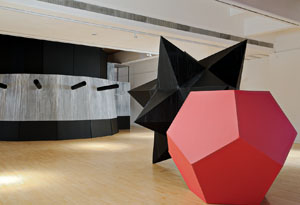Sarah Shalgosky sees university galleries as playing a broad and valuable role in the wider context of the visual arts

The opening of the glorious new extension to the Ashmolean Museum in Oxford has perhaps eclipsed a more understated expansion of university galleries across the UK. A plethora of new gallery spaces for the exhibition of contemporary art practice have been created, most as developments within art schools. In tandem, recent conferences at the Universities of Cork, Warwick and Bournemouth have initiated a critical examination of the roles of the university art gallery that extend beyond delivery of teaching, learning and research. How might they contribute to a wider, sustainable cultural ecology, and create a permeable interface between higher education institutions and the communities that surround them?
Inevitably, this wider agenda is linked to the implementation of the Research Excellence Framework (REF) for all universities in the UK, which will be completed in 2014. The metrics to assess the impact of research in the practice-based creative arts include ‘reach’, which identifies the range of impact – not just in terms of distance but in terms of duration and saturation – and ‘significance’, which examines the transformative effects of the art practice. Quantitative measures such as audience figures, distance travelled by visitors and numbers of talks or conferences offer contextual information. However, in terms of the REF, they do not in themselves demonstrate impact. This is identified through qualitative measures that focus on critical reception of the exhibition programme and the work it presents, including visitor feedback, reviews, awards and analysis by expert peers.
Of course, the quest to find ways to measure the value of an arts programme is not just confined to university galleries. Quantitative measures are widely implemented, from the hand-click count of visitors entering the building to box office systems that identify visitors’ home postcodes and ‘buyer types’: child, adult, student, carer. They provide headline statistics that are still central to many stakeholder evaluations of art museums and galleries, albeit statistics that respond to the level of marketing budgets and the public profile of the artists concerned, rather than to the intrinsic merit of the exhibition. Qualitative analysis is more difficult and more expensive to deliver but visitor feedback, critical response and long-term examination of audience trends have been incorporated into the performance indicators of most institutions.
The peer review is less widely implemented. An important measure of the significance of academic research, it has yet to be implemented consistently across the gallery sector. Where it does take place, it is likely to be part of a singular exercise rather than a sustained, long-term programme of evaluation. The REF offers scope for the development of a network of peers to review activity, to take an expert view of the significance of gallery programmes both within and beyond the university sector. It is possible to conceive this network as a cross-sector forum for mentoring and professional development, providing a focus for leadership and advocacy.
The new generation of university galleries is associated with the pedagogy of art practice rather than art history. However, in form, most replicate the white cube of the commercial gallery sector rather than the studio or the project space. Perhaps this is not as counter-intuitive as might seem. In the commercial space, the relative significance of art practice is evaluated through scholarly catalogue texts, critical reviews and, ultimately, sale to public or private collectors – the supreme form of visitor feedback. However, in the UK, the art market is almost completely confined to London, and there is a constant shift of young artists to the capital in search of opportunities. An additional role for university galleries could be the development of commercial spaces, possibly in partnership with social enterprise. This might operate at a local and regional level – an excellent case study was discussed at the conference organised by Bournemouth Institute of Art and Design in January 2012 and featured Bar Lane Studios, which works with York St John University to support graduate entry into business. But the demise of EAST at Norwich School of Art has left a lacuna for another major international exhibition to showcase emerging talent.
EAST prioritised a progressive view of contemporary practice. It was an open submission exhibition that ran each summer from 1991 to 2009. The exhibitions introduced an extraordinary range of artists including Hurvin Anderson, Martin Creed, Runa Islam and George Shaw. It is hard to think of another gallery that has so consistently identified generation after generation of artists whose work subsequently received widespread critical acclaim. It seems scarcely possible that a small gallery in Norwich could make such a huge contribution to the vitality of contemporary art practice. Examining the phenomenon more closely, the selectors were always a combination of an artist – sometimes at the beginning of their career, sometimes towards the end – and a gallerist. The sustained enterprise to evaluate contemporary art practice drew large audiences from the sector as well as from the general public, while debates and projects fostered a critical analysis of the exhibition and the work it contained.
Although the new investment in many university galleries may have its origins in the maximisation of research impact ready for the 2014 REF, it may help to refocus the wider sector. The metrics of reach and significance prioritise a long-term endeavour that is informed by expert incisive analysis rather than documented by the blunt instruments of data.
Sarah Shalgosky is Curator at the University of Warwick.
W www.warwickartscentre.co.uk



